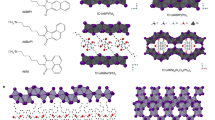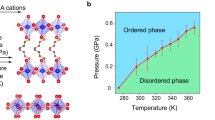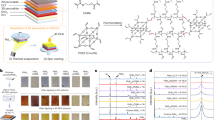Abstract
Inorganic perovskite solar cells could benefit from surface passivation using 2D/3D perovskite heterostructures. However, conventional spacer cations fail to exchange with the tightly bonded Cs cation in the inorganic perovskite to form 2D layers atop; or, when they do enable formation of a 2D layer, they migrate under heat, degrading device performance. Here we investigate the mechanisms behind 2D/3D heterostructure formation and stabilization. We find that 2D/3D heterostructure formation is driven by interactions between ammonium groups and [PbI6]4− octahedra. We thus incorporate electron-withdrawing fluorine to enhance inorganic–organic cation interdiffusion and promote heterostructure formation. We note that stability relies on interactions between the entire spacer cations and [PbI6]4− octahedra. We therefore introduce anchoring groups that double cation desorption energies, preventing cation migration at elevated temperatures. CsPbI3/(perfluoro-1,4-phenylene)dimethanammonium lead iodide heterostructures enable an efficiency of 21.6% and a maximum power point operating stability at 85 °C of 950 h. We demonstrate 16-cm2 modules with an efficiency of 19.8%.
This is a preview of subscription content, access via your institution
Access options
Access Nature and 54 other Nature Portfolio journals
Get Nature+, our best-value online-access subscription
$32.99 / 30 days
cancel any time
Subscribe to this journal
Receive 12 digital issues and online access to articles
$119.00 per year
only $9.92 per issue
Buy this article
- Purchase on SpringerLink
- Instant access to full article PDF
Prices may be subject to local taxes which are calculated during checkout





Similar content being viewed by others
Data availability
The data that support the findings of this study are provided in Supplementary Information. Source data are provided with this paper.
References
Wang, Y. et al. Thermodynamically stabilized β-CsPbI3-based perovskite solar cells with efficiencies >18%. Science 365, 591–595 (2019).
Liu, C. et al. Retarding solid-state reactions enable efficient and stable all-inorganic perovskite solar cells and modules. Sci. Adv. 9, eadg0087 (2023).
Swarnkar, A. et al. Quantum dot-induced phase stabilization of α-CsPbI3 perovskite for high-efficiency photovoltaics. Science 354, 92–95 (2016).
Gu, H. et al. Phase-pure two-dimensional layered perovskite thin films. Nat. Rev. Mater. 8, 533–551 (2023).
Zhao, X. et al. Accelerated aging of all-inorganic, interface-stabilized perovskite solar cells. Science 377, 307–310 (2022).
Chen, H. et al. Improved charge extraction in inverted perovskite solar cells with dual-site-binding ligands. Science 384, 189–193 (2024).
Wang, Z. et al. Managing multiple halide-related defects for efficient and stable inorganic perovskite solar cells. Angew. Chem. Int. Ed. 62, e202305815 (2023).
Sun, X. et al. Highly efficient CsPbI3/Cs1-xDMAxPbI3 bulk heterojunction perovskite solar cell. Joule 6, 850–860 (2022).
Chu, X. et al. Surface in situ reconstruction of inorganic perovskite films enabling long carrier lifetimes and solar cells with 21% efficiency. Nat. Energy 8, 372–380 (2023).
Tan, S. et al. Temperature-reliable low-dimensional perovskites passivated black-phase CsPbI3 toward stable and efficient photovoltaics. Angew. Chem. Int. Ed. 61, e202201300 (2022).
Li, T. et al. Inorganic wide-bandgap perovskite subcells with dipole bridge for all-perovskite tandems. Nat. Energy 8, 610–620 (2023).
Mali, S. S. et al. All-inorganic halide perovskites for air-processed “n–i–p” monolithic perovskite/organic hybrid tandem solar cells exceeding 23% efficiency. Energy Environ. Sci. 17, 1046–1060 (2024).
Wang, Z. et al. Suppressed phase segregation for triple-junction perovskite solar cells. Nature 618, 74–79 (2023).
Wang, X., Wang, Y., Chen, Y., Liu, X. & Zhao, Y. Efficient and stable CsPbI3 inorganic perovskite photovoltaics enabled by crystal secondary growth. Adv. Mater. 33, 2103688 (2021).
Zhang, Z. et al. Rationalization of passivation strategies toward high-performance perovskite solar cells. Chem. Soc. Rev. 52, 163–195 (2023).
Yang, Y. et al. A thermotropic liquid crystal enables efficient and stable perovskite solar modules. Nat. Energy 9, 316–323 (2024).
Liu, C. et al. Bimolecularly passivated interface enables efficient and stable inverted perovskite solar cells. Science 382, 810–815 (2023).
Steele, J. A. et al. Thermal unequilibrium of strained black CsPbI3 thin films. Science 365, 679–684 (2019).
Sutton, R. J. et al. Cubic or orthorhombic? Revealing the crystal structure of metastable black-phase CsPbI3 by theory and experiment. ACS Energy Lett. 3, 1787–1794 (2018).
Heo, J. H. et al. Surface engineering with oxidized Ti3C2Tx MXene enables efficient and stable p–i–n-structured CsPbI3 perovskite solar cells. Joule 6, 1672–1688 (2022).
Wu, L. et al. Stabilization of inorganic perovskite solar cells with a 2D Dion–Jacobson passivating layer. Adv. Mater. 35, 2304150 (2023).
Du, Y. et al. Manipulating the formation of 2D/3D heterostructure in stable high-performance printable CsPbI3 perovskite solar cells. Adv. Mater. 35, 2206451 (2023).
Liu, X. et al. Organic tetrabutylammonium cation intercalation to heal inorganic CsPbI3 perovskite. Angew. Chem. Int. Ed. 60, 12351–12355 (2021).
Wang, Y. et al. Efficient α-CsPbI3 photovoltaics with surface terminated organic cations. Joule 2, 2065–2075 (2018).
Sidhik, S. et al. Deterministic fabrication of 3D/2D perovskite bilayer stacks for durable and efficient solar cells. Science 377, 1425–1430 (2022).
Sutanto, A. et al. In situ analysis reveals the role of 2D perovskite in preventing thermal-induced degradation in 2D/3D perovskite interfaces. Nano Lett. 20, 3992–3998 (2020).
Szabó, G. & Kamat, P. V. How cation migration across a 2D/3D interface dictates perovskite solar cell efficiency. ACS Energy Lett. 9, 193–200 (2024).
Perini, C. A. R. et al. Interface reconstruction from Ruddlesden–Popper structures impacts stability in lead halide perovskite solar cells. Adv. Mater. 34, 2204726 (2022).
Liu, C. et al. Tuning structural isomers of phenylenediammonium to afford efficient and stable perovskite solar cells and modules. Nat. Commun. 12, 6394 (2021).
Wang, Y., Zhang, T., Kan, M. & Zhao, Y. Bifunctional stabilization of all-inorganic α-CsPbI3 perovskite for 17% efficiency photovoltaics. J. Am. Chem. Soc. 140, 12345–12348 (2018).
Yoon, S. M. et al. Surface engineering of ambient-air-processed cesium lead triiodide layers for efficient solar cells. Joule 5, 183–196 (2021).
Almalki, M. et al. Nanosegregation in arene-perfluoroarene π-systems for hybrid layered Dion–Jacobson perovskites. Nanoscale 14, 6771–6776 (2022).
Li, X., Hoffman, J. M. & Kanatzidis, M. G. The 2D halide perovskite rulebook: how the spacer influences everything from the structure to optoelectronic device efficiency. Chem. Rev. 121, 2230–2291 (2021).
Sun, H. et al. Surface defects management by in situ etching with methanol for efficient inverted inorganic perovskite solar cells. Adv. Funct. Mater. 33, 2213913 (2023).
Sheikh, T., Shinde, A., Mahamuni, S. & Nag, A. Possible dual bandgap in (C4H9NH3)2PbI4 2D layered perovskite: single-crystal and exfoliated few-layer. ACS Energy Lett. 3, 2940–2946 (2018).
Ummadisingu, A. et al. Multi-length scale structure of 2D/3D Dion–Jacobson hybrid perovskites based on an aromatic diammonium spacer. Small 18, 2104287 (2022).
Papavassiliou, G. C., Mousdis, G. A., Raptopoulou, C. P. & Terzis, A. Preparation and characterization of [C6H5CH2NH3]2PbI4, [C6H5CH2CH2SC(NH2)2]3PbI5 and [C10H7CH2NH3]PbI3 organic-inorganic hybrid compounds. Z. Naturforsch. B. 54, 1405–1409 (1999).
Li, F. et al. Hydrogen-bond-bridged intermediate for perovskite solar cells with enhanced efficiency and stability. Nat. Photonics 17, 478–484 (2023).
Lin, L. et al. Hydrogen bonding in perovskite solar cells. Matter 7, 38–58 (2024).
Abate, A. et al. Supramolecular halogen bond passivation of organic–inorganic halide perovskite solar cells. Nano Lett. 14, 3247–3254 (2014).
Han, C. et al. Impact and role of epitaxial growth in metal halide perovskite solar cells. ACS Mater. Lett. 5, 2445–2463 (2023).
Hong, H. et al. Two-dimensional lead halide perovskite lateral homojunctions enabled by phase pinning. Nat. Commun. 15, 3164 (2024).
Stoumpos, C. C. et al. Ruddlesden–Popper hybrid lead iodide perovskite 2D homologous semiconductors. Chem. Mater. 28, 2852–2867 (2016).
Sidhik, S. et al. Two-dimensional perovskite templates for durable, efficient formamidinium perovskite solar cells. Science 384, 1227–1235 (2024).
Liu, C. et al. Dopant-free hole transport materials afford efficient and stable inorganic perovskite solar cells and modules. Angew. Chem. Int. Ed. 60, 20489–20497 (2021).
Heo, J. H. et al. Efficient and stable graded CsPbI3−xBrx perovskite solar cells and submodules by orthogonal processable spray coating. Joule 5, 481–494 (2021).
Liu, C. et al. Tailoring C60 for efficient inorganic CsPbI2Br perovskite solar cells and modules. Adv. Mater. 32, 1907361 (2020).
Chen, R. et al. Moisture-tolerant and high-quality α-CsPbI3 films for efficient and stable perovskite solar modules. J. Mater. Chem. A 8, 9597–9606 (2020).
Heo, J. H. et al. Thermally stable inorganic CsPbI2Br mesoscopic metal halide perovskite solar submodules. ACS Appl. Mater. Interfaces 11, 43066–43074 (2019).
Tan, S. et al. Constructing an interfacial gradient heterostructure enables efficient CsPbI3 perovskite solar cells and printed minimodules. Adv. Mater. 35, 2301879 (2023).
Mali, S. S. et al. Phase-heterojunction all-inorganic perovskite solar cells surpassing 21.5% efficiency. Nat. Energy 8, 989–1001 (2023).
Liu, X. et al. CsPbI3 perovskite solar module with certified aperture area efficiency >18% based on ambient-moisture-assisted surface hydrolysis. Joule 8, 2851–2862 (2024).
Zhou, Q. et al. High-performance perovskite solar cells with enhanced environmental stability based on a (p-FC6H4C2H4NH3)2[PbI4] capping layer. Adv. Energy Mater. 9, 1802595 (2019).
Paek, S. et al. Molecular design and operational stability: toward stable 3D/2D perovskite interlayers. Adv. Sci. 7, 2001014 (2020).
Kresse, G. & Furthmüller, J. Efficient iterative schemes for ab initio total-energy calculations using a plane-wave basis set. Phys. Rev. B 54, 11169–11186 (1996).
Perdew, J. P., Burke, K. & Ernzerhof, M. Generalized gradient approximation made simple. Phys. Rev. Lett. 77, 3865–3868 (1996).
Grimme, S., Antony, J., Ehrlich, S. & Krieg, H. A consistent and accurate ab initio parametrization of density functional dispersion correction (DFT-D) for the 94 elements H–Pu. J. Chem. Phys. 132, 154104 (2010).
Kresse, G. & Joubert, D. From ultrasoft pseudopotentials to the projector augmented-wave method. Phys. Rev. B 59, 1758–1775 (1999).
Acknowledgements
M.K.N. acknowledges support from the European Union’s Horizon 2020 research and innovation programme (number 763977). E.H.S. acknowledges support from the award 70NANB19H005 from the US Department of Commerce, National Institute of Standards and Technology, as part of the Center for Hierarchical Materials Design (CHiMaD). J.D.F. and M.G.K. acknowledge support from the National Science Foundation under grant number DMR-2019444 (National Science Foundation Center for Integration of Modern Optoelectronic Materials on Demand, IMOD, X-ray crystallographic and optical studies of 2D perovskites). I.W.G. was supported by US Department of Energy, Office of Science, Basic Energy Sciences, under award number DE-SC-0012541 (single-crystal X-ray crystal structure determination). K.R. thanks the Research Council of Lithuania via grant number S-MIP-20-20 and the funding received from the World Federation of Scientists (WFS) fellowship. This work made use of the EPIC facility of Northwestern University’s NUANCE Center, which has received support from the SHyNE Resource (National Science Foundation ECCS-2025633), the IIN and Northwestern’s MRSEC programme (National Science Foundation DMR-1720139). We thank C. Ballif and C. Wolf for assisting with module measurements. We also acknowledge O.A. Syzgantseva and M.A. Syzgantseva for suggestions on theoretical calculations and C. Igci and S. Dai for support with material synthesis and characterization. A.S.R.B. acknowledges support from King Abdullah University of Science and Technology through the Ibn Rushd Postdoctoral Fellowship Award.
Author information
Authors and Affiliations
Contributions
C.L. conceived of the idea and proposed the experimental design. C.L. and Y.Y. performed the device fabrication and characterizations. A.L., Z.W., H.Z. and B.C. gave suggestions on the paper writing. J.D.F. and I.W.G. performed synthesis, physico-chemical analysis and crystallographic single-crystal analysis. C.B.M. performed DFT calculation. R.P.R., K.R., R.S. and V.G. synthesized organic halides. B.D., Y.D., L.Z., Z.W. and X.Z. helped with the device fabrication. H.C., H.W. and A.S.R.B. helped with photoluminescence (PL) measurement. N.S. performed the GIWAXS measurement. K.R., P.J.D., M.G.K., M.K.N. and E.H.S. supervised the project. C.L. wrote the first draft of the paper. All the authors contributed to the revision and comments to the paper.
Corresponding authors
Ethics declarations
Competing interests
The authors declare no competing interests.
Peer review
Peer review information
Nature Energy thanks Tongle Bu and the other, anonymous, reviewers for their contribution to the peer review of this work.
Additional information
Publisher’s note Springer Nature remains neutral with regard to jurisdictional claims in published maps and institutional affiliations.
Supplementary information
Supplementary Information
Supplementary Figs. 1–33, Tables 1–19 and Refs. 1–11.
Supplementary Data 1
Statistical source data for Supplementary Figs. 1, 7, 21 and 23.
Source data
Source Data Fig. 5
Statistical source data for Fig. 5c.
Rights and permissions
Springer Nature or its licensor (e.g. a society or other partner) holds exclusive rights to this article under a publishing agreement with the author(s) or other rightsholder(s); author self-archiving of the accepted manuscript version of this article is solely governed by the terms of such publishing agreement and applicable law.
About this article
Cite this article
Liu, C., Yang, Y., Fletcher, J.D. et al. Cation interdiffusion control for 2D/3D heterostructure formation and stabilization in inorganic perovskite solar modules. Nat Energy 10, 981–990 (2025). https://doi.org/10.1038/s41560-025-01817-6
Received:
Accepted:
Published:
Issue date:
DOI: https://doi.org/10.1038/s41560-025-01817-6



